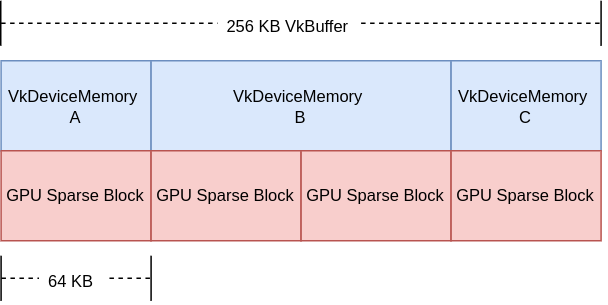稀疏资源
Vulkan 稀疏资源是一种创建VkBuffer和VkImage对象的方法,这些对象可以不连续地绑定到一个或多个VkDeviceMemory分配上,Vulkan Spec详细说明了稀疏资源的许多功能特性。implementation guidelines指出,大多数驱动使用稀疏资源向应用程序公开内存的线性虚拟地址范围,同时在绑定时将每个稀疏块映射到物理页。
绑定稀疏内存
与调用vkBindBufferMemory()或vkBindImageMemory()绑定普通资源不同的是,稀疏内存是通过 queue operation绑定的。这样做的主要优点是,应用程序可以在其整个生命周期内将内存重新绑��定到一个稀疏资源。
注意,应用程序必须使用同步原语来保证其他队列不会在绑定更改的同时访问这块内存。另外应用程序不得访问绑定到已释放内存的资源。
稀疏缓冲区
以下示例展示了稀疏VkBuffer在内存中的分布。多数驱动实现使用 64 KB 的VkBuffer稀疏块大小(实际大小在VkMemoryRequirements::alignment中返回)。
假设有一个 256 KB 的VkBuffer,应用程序需要单独更新 3 个Section:
- Section A - 64 KB
- Section B - 128 KB
- Section C - 64 KB
应用程序看到的VkBuffer 视图:

稀疏图像
Mip 尾部区域
稀疏图像可用于单独更新 mip levels,从而产生 mip 尾部区域。
基本稀疏资源示例
下面是一个创建稀疏图像并将其绑定到物理内存的示例,创建一个普通VkImage对象,分配精细内存来支持具有多个内存范围的资源。
VkDevice device;
VkQueue queue;
VkImage sparseImage;
VkAllocationCallbacks* pAllocator = NULL;
VkMemoryRequirements memoryRequirements = {};
VkDeviceSize offset = 0;
VkSparseMemoryBind binds[MAX_CHUNKS] = {}; // MAX_CHUNKS is NOT part of Vulkan
uint32_t bindCount = 0;
// ...
// Allocate image object
const VkImageCreateInfo sparseImageInfo =
{
VK_STRUCTURE_TYPE_IMAGE_CREATE_INFO, // sType
NULL, // pNext
VK_IMAGE_CREATE_SPARSE_BINDING_BIT | ..., // flags
...
};
vkCreateImage(device, &sparseImageInfo, pAllocator, &sparseImage);
// Get memory requirements
vkGetImageMemoryRequirements(
device,
sparseImage,
&memoryRequirements);
// Bind memory in fine-grained fashion, find available memory ranges
// from potentially multiple VkDeviceMemory pools.
// (Illustration purposes only, can be optimized for perf)
while (memoryRequirements.size && bindCount < MAX_CHUNKS)
{
VkSparseMemoryBind* pBind = &binds[bindCount];
pBind->resourceOffset = offset;
AllocateOrGetMemoryRange(
device,
&memoryRequirements,
&pBind->memory,
&pBind->memoryOffset,
&pBind->size);
// memory ranges must be sized as multiples of the alignment
assert(IsMultiple(pBind->size, memoryRequirements.alignment));
assert(IsMultiple(pBind->memoryOffset, memoryRequirements.alignment));
memoryRequirements.size -= pBind->size;
offset += pBind->size;
bindCount++;
}
// Ensure entire image has backing
if (memoryRequirements.size)
{
// Error condition - too many chunks
}
const VkSparseImageOpaqueMemoryBindInfo opaqueBindInfo =
{
sparseImage, // image
bindCount, // bindCount
binds // pBinds
};
const VkBindSparseInfo bindSparseInfo =
{
VK_STRUCTURE_TYPE_BIND_SPARSE_INFO, // sType
NULL, // pNext
...
1, // imageOpaqueBindCount
&opaqueBindInfo, // pImageOpaqueBinds
...
};
// vkQueueBindSparse is externally synchronized per queue object.
AcquireQueueOwnership(queue);
// Actually bind memory
vkQueueBindSparse(queue, 1, &bindSparseInfo, VK_NULL_HANDLE);
ReleaseQueueOwnership(queue);
高级稀疏资源
这个更复杂一点的示例创建颜色附件/纹理图像数组,并仅将0级LOD和所需的元数据绑定到物理内存:
VkDevice device;
VkQueue queue;
VkImage sparseImage;
VkAllocationCallbacks* pAllocator = NULL;
VkMemoryRequirements memoryRequirements = {};
uint32_t sparseRequirementsCount = 0;
VkSparseImageMemoryRequirements* pSparseReqs = NULL;
VkSparseMemoryBind binds[MY_IMAGE_ARRAY_SIZE] = {};
VkSparseImageMemoryBind imageBinds[MY_IMAGE_ARRAY_SIZE] = {};
uint32_t bindCount = 0;
// Allocate image object (both renderable and sampleable)
const VkImageCreateInfo sparseImageInfo =
{
VK_STRUCTURE_TYPE_IMAGE_CREATE_INFO, // sType
NULL, // pNext
VK_IMAGE_CREATE_SPARSE_RESIDENCY_BIT | ..., // flags
...
VK_FORMAT_R8G8B8A8_UNORM, // format
...
MY_IMAGE_ARRAY_SIZE, // arrayLayers
...
VK_IMAGE_USAGE_COLOR_ATTACHMENT_BIT |
VK_IMAGE_USAGE_SAMPLED_BIT, // usage
...
};
vkCreateImage(device, &sparseImageInfo, pAllocator, &sparseImage);
// Get memory requirements
vkGetImageMemoryRequirements(
device,
sparseImage,
&memoryRequirements);
// Get sparse image aspect properties
vkGetImageSparseMemoryRequirements(
device,
sparseImage,
&sparseRequirementsCount,
NULL);
pSparseReqs = (VkSparseImageMemoryRequirements*)
malloc(sparseRequirementsCount * sizeof(VkSparseImageMemoryRequirements));
vkGetImageSparseMemoryRequirements(
device,
sparseImage,
&sparseRequirementsCount,
pSparseReqs);
// Bind LOD level 0 and any required metadata to memory
for (uint32_t i = 0; i < sparseRequirementsCount; ++i)
{
if (pSparseReqs[i].formatProperties.aspectMask &
VK_IMAGE_ASPECT_METADATA_BIT)
{
// Metadata must not be combined with other aspects
assert(pSparseReqs[i].formatProperties.aspectMask ==
VK_IMAGE_ASPECT_METADATA_BIT);
if (pSparseReqs[i].formatProperties.flags &
VK_SPARSE_IMAGE_FORMAT_SINGLE_MIPTAIL_BIT)
{
VkSparseMemoryBind* pBind = &binds[bindCount];
pBind->memorySize = pSparseReqs[i].imageMipTailSize;
bindCount++;
// ... Allocate memory range
pBind->resourceOffset = pSparseReqs[i].imageMipTailOffset;
pBind->memoryOffset = /* allocated memoryOffset */;
pBind->memory = /* allocated memory */;
pBind->flags = VK_SPARSE_MEMORY_BIND_METADATA_BIT;
}
else
{
// Need a mip tail region per array layer.
for (uint32_t a = 0; a < sparseImageInfo.arrayLayers; ++a)
{
VkSparseMemoryBind* pBind = &binds[bindCount];
pBind->memorySize = pSparseReqs[i].imageMipTailSize;
bindCount++;
// ... Allocate memory range
pBind->resourceOffset = pSparseReqs[i].imageMipTailOffset +
(a * pSparseReqs[i].imageMipTailStride);
pBind->memoryOffset = /* allocated memoryOffset */;
pBind->memory = /* allocated memory */
pBind->flags = VK_SPARSE_MEMORY_BIND_METADATA_BIT;
}
}
}
else
{
// resource data
VkExtent3D lod0BlockSize =
{
AlignedDivide(
sparseImageInfo.extent.width,
pSparseReqs[i].formatProperties.imageGranularity.width);
AlignedDivide(
sparseImageInfo.extent.height,
pSparseReqs[i].formatProperties.imageGranularity.height);
AlignedDivide(
sparseImageInfo.extent.depth,
pSparseReqs[i].formatProperties.imageGranularity.depth);
}
size_t totalBlocks =
lod0BlockSize.width *
lod0BlockSize.height *
lod0BlockSize.depth;
// Each block is the same size as the alignment requirement,
// calculate total memory size for level 0
VkDeviceSize lod0MemSize = totalBlocks * memoryRequirements.alignment;
// Allocate memory for each array layer
for (uint32_t a = 0; a < sparseImageInfo.arrayLayers; ++a)
{
// ... Allocate memory range
VkSparseImageMemoryBind* pBind = &imageBinds[a];
pBind->subresource.aspectMask = pSparseReqs[i].formatProperties.aspectMask;
pBind->subresource.mipLevel = 0;
pBind->subresource.arrayLayer = a;
pBind->offset = (VkOffset3D){0, 0, 0};
pBind->extent = sparseImageInfo.extent;
pBind->memoryOffset = /* allocated memoryOffset */;
pBind->memory = /* allocated memory */;
pBind->flags = 0;
}
}
free(pSparseReqs);
}
const VkSparseImageOpaqueMemoryBindInfo opaqueBindInfo =
{
sparseImage, // image
bindCount, // bindCount
binds // pBinds
};
const VkSparseImageMemoryBindInfo imageBindInfo =
{
sparseImage, // image
sparseImageInfo.arrayLayers, // bindCount
imageBinds // pBinds
};
const VkBindSparseInfo bindSparseInfo =
{
VK_STRUCTURE_TYPE_BIND_SPARSE_INFO, // sType
NULL, // pNext
...
1, // imageOpaqueBindCount
&opaqueBindInfo, // pImageOpaqueBinds
1, // imageBindCount
&imageBindInfo, // pImageBinds
...
};
// vkQueueBindSparse is externally synchronized per queue object.
AcquireQueueOwnership(queue);
// Actually bind memory
vkQueueBindSparse(queue, 1, &bindSparseInfo, VK_NULL_HANDLE);
ReleaseQueueOwnership(queue);